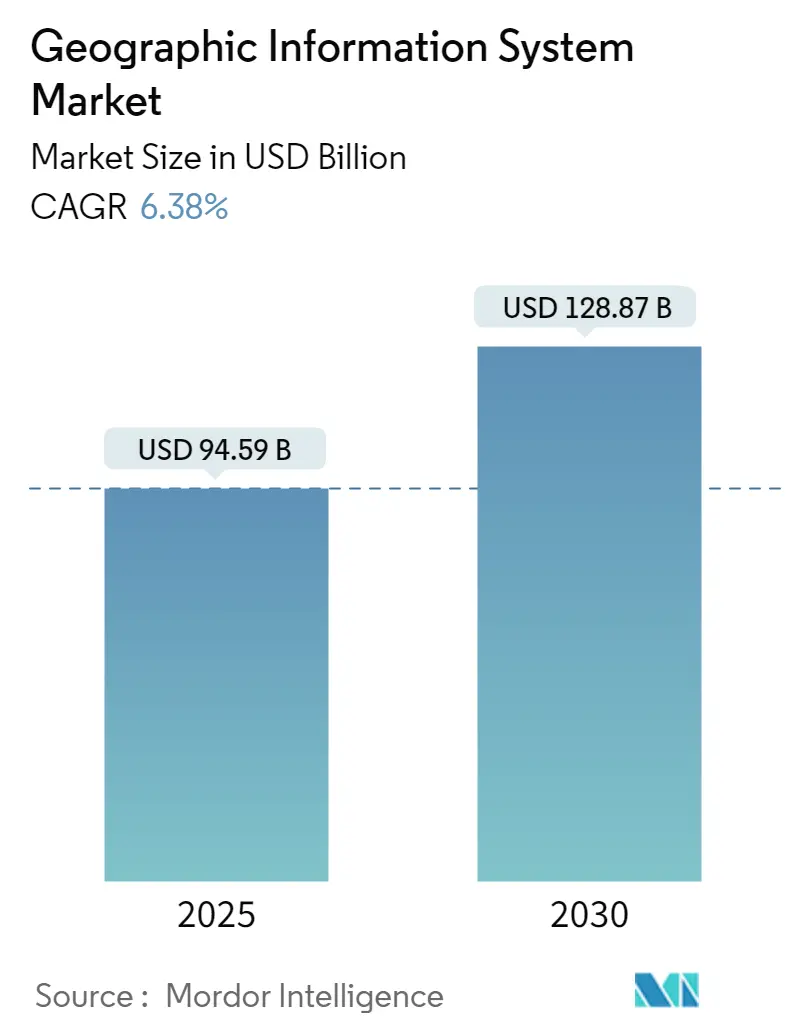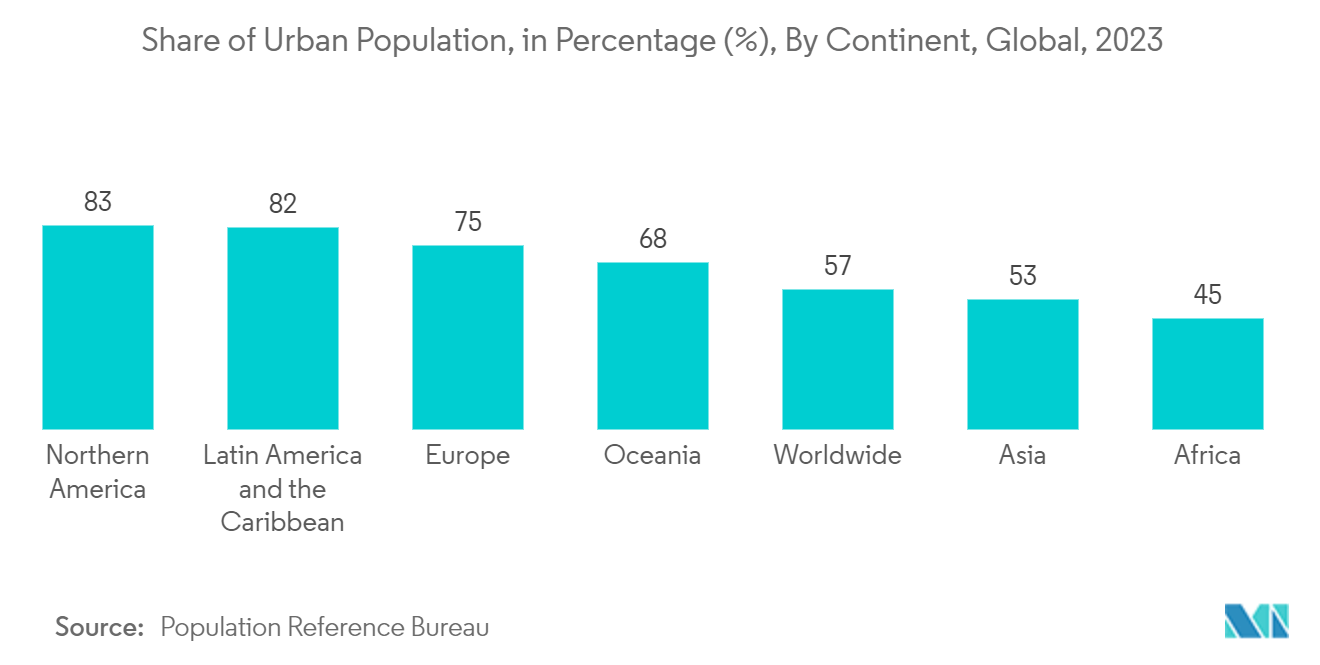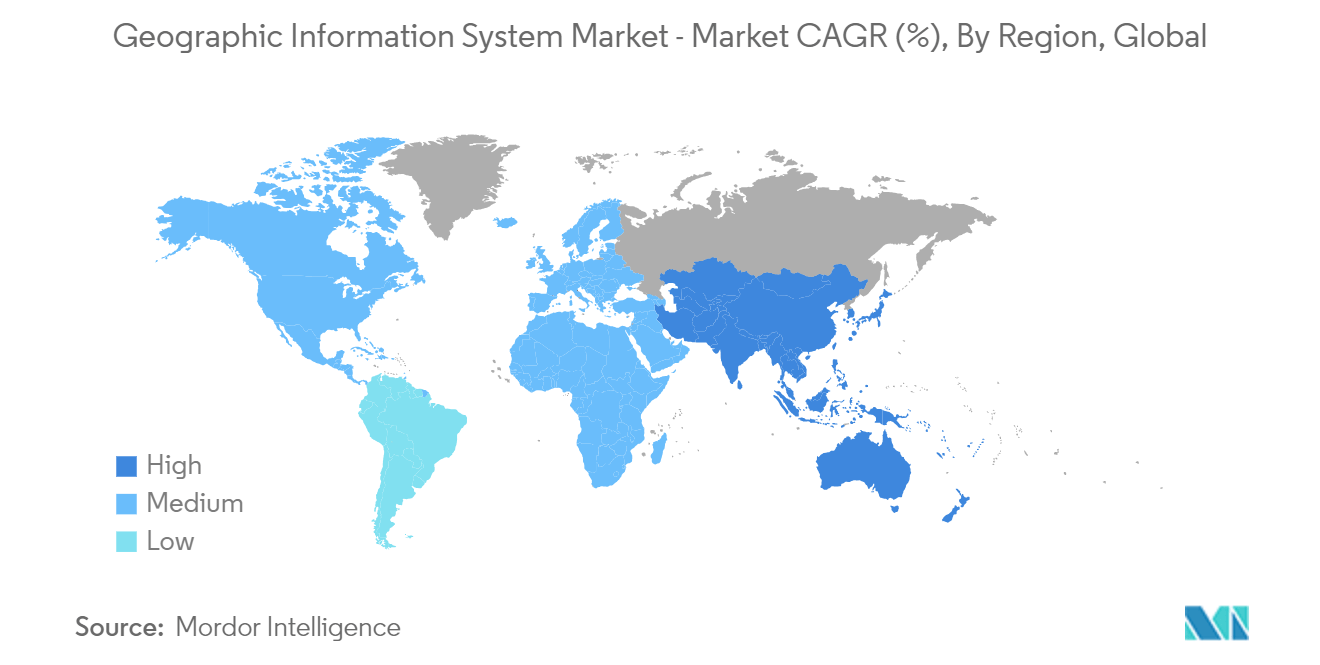Geographic Information System (GIS) Market Analysis
The Geographic Information System Market size is estimated at USD 94.59 billion in 2025, and is expected to reach USD 128.87 billion by 2030, at a CAGR of 6.38% during the forecast period (2025-2030).
The Geographic Information System (GIS) market has evolved into a critical technology across industries, leveraging spatial data to enhance decision-making processes. GIS allows organizations to capture, store, analyze, and visualize geographic information, making it invaluable for applications in urban planning, infrastructure management, and environmental monitoring. The rise of smart cities and advancements in geospatial data have significantly expanded the adoption of GIS in sectors such as agriculture, utilities, and construction.
Key Fundamentals of the GIS Market
- Increased Relevance in Modern Business: The GIS market has grown significantly due to its integration into business environments. Both governments and private enterprises are investing heavily in GIS technologies to optimize operations, improve service delivery, and drive sustainable development. Additionally, advances in hardware and software have enhanced the precision and usability of GIS tools. For instance, cloud-based GIS offers scalability and collaborative features, contributing to the industry's shift toward data-driven solutions.
- Integration with Emerging Technologies: The GIS market is expanding due to its ability to integrate with other technologies like Artificial Intelligence (AI) and the Internet of Things (IoT). This convergence allows for real-time data collection and predictive analytics, spurring demand across industries. Geographic information system solutions have seen significant advancements in geospatial intelligence, pushing the boundaries of innovation in data analysis and spatial mapping.
- Challenges in Data Quality and Legacy System Integration: While GIS adoption is growing, challenges like data quality and the integration of GIS with legacy systems hinder seamless deployment in some regions. Organizations need to invest in data accuracy and infrastructure modernization to overcome these barriers, ensuring that GIS solutions meet the growing demand for precise spatial data.
Adoption of GIS in Smart Cities
- Essential Role in Urban Planning: As urbanization accelerates, GIS has become central to smart city development. Urban planners use GIS to manage infrastructure, optimize transportation networks, and enhance public safety. GIS processes vast amounts of spatial data, providing insights that improve city management and resource allocation.
- Infrastructure Optimization: GIS aids urban planners in mapping resources, land use, and infrastructure development, supporting sustainable city designs.
- Real-Time Monitoring: Through real-time data feeds, GIS monitors energy consumption, traffic patterns, and emergency responses, streamlining city operations.
- Digital Twins: GIS supports the creation of digital twins, virtual city models that simulate urban developments, predicting the impact of changes before physical implementation.
Integration of GIS with Business Intelligence
- Transforming Business Analytics: One of the most significant trends in the GIS market is its integration with Business Intelligence (BI) tools. This convergence enables businesses to layer location-based data with performance metrics, generating deeper insights into customer behavior, market opportunities, and supply chain efficiencies.
- Geographical Visualization of Data: Integrating GIS with BI tools allows businesses to visualize operational data geographically, offering new perspectives on efficiency.
- Industry-Specific Benefits: Sectors like retail, logistics, and telecommunications benefit from GIS, optimizing resource allocation, improving market strategies, and driving customer engagement.
- Predictive Analytics: Businesses can use GIS with predictive analytics to anticipate demand trends, identify high-potential regions, and mitigate risks, enhancing decision-making processes.
Integration Challenges with Traditional Systems
- Complexity in Synchronization: Integrating GIS with traditional enterprise systems, such as enterprise resource planning (ERP) or customer relationship management (CRM) platforms, can be complex, especially for organizations relying on outdated technology.
- Legacy Systems: Many organizations struggle to synchronize GIS with older data management platforms, leading to operational inefficiencies.
- Significant Investments Needed: Integration often requires substantial investments in software upgrades and personnel training to ensure smooth GIS adoption.
- Data Duplication Risks: Misalignment between traditional databases and modern GIS solutions can result in data duplication or errors, compromising the value of spatial information.
Data Quality and Accuracy Concerns
- The Importance of High-Quality Data: For GIS applications to deliver accurate insights, the data inputted must meet high standards of quality and precision. However, data accuracy remains a concern for many users, especially in agriculture, construction, and transportation, where errors in spatial data can lead to costly consequences.
- Inconsistent Data Collection: Inaccurate GIS analysis often stems from inconsistent data collection methods or outdated datasets.
- Challenges in Developing Regions: In developing regions, access to advanced data-gathering tools is limited, further compromising the quality of GIS data.
- Solutions for Improved Accuracy: Investments in high-resolution satellite imagery, real-time data acquisition technologies, and robust data validation processes are crucial for addressing these data quality challenges.
Geographic Information System (GIS) Market Trends
The Rising Smart Cities Development and Urban Planning to Drive the Market Growth
- Smart Cities Drive GIS Market Growth: The rise of smart cities and advanced urban planning needs are key drivers of the GIS market. Smart cities depend on GIS technology to efficiently manage infrastructure, resources, and essential services, reflecting the increasing demand for technology that supports urban expansion and planning.
- Infrastructure and Resource Management: GIS is essential for managing urban systems like transportation, energy, and water supply, contributing to the growth of the GIS market.
- Sustainability in Urban Design: Urban planners use GIS to develop sustainable, livable cities by optimizing land use, monitoring traffic, and assessing demographic trends.
- Enhanced Decision-Making with GIS Technology: Governments and urban developers use GIS to analyze spatial data for informed decision-making, particularly in infrastructure development and environmental risk management. This reliance on GIS is essential in addressing the challenges of rapid urbanization and sustainable development.
Asia-Pacific to Register Highest Market Growth
- Rapid Urbanization and Government Initiatives: The Asia-Pacific region is expected to experience the highest growth in the GIS market due to rapid urbanization, government investments, and technological advancements. Countries like China and India lead GIS adoption, particularly through smart city initiatives and infrastructure development projects.
- Government-Backed Projects: Initiatives like India’s Digital India and China's smart city programs are accelerating GIS integration in sectors such as urban planning and disaster management.
- Key Industry Applications: GIS is widely used in agriculture, transportation, and utilities in the Asia-Pacific, contributing significantly to the region's overall GIS market growth.
- Technological Innovation in GIS: Emerging technologies like AI and IoT are further driving GIS adoption in Asia-Pacific, delivering more accurate geospatial data and analytics. With governments and enterprises investing heavily in GIS, the market value is set to climb steadily in the coming years.
Geographic Information System (GIS) Industry Overview
Semi-Consolidated Market: The GIS market is moderately consolidated, with dominant players like Autodesk Inc., Bentley Systems, and Hexagon AB leading innovation and adoption. While a few large companies dominate, regional competitors and niche players still find opportunities to offer industry-specific solutions.
Technological Leadership: Companies like Hexagon AB and Pitney Bowes Inc. lead through extensive global operations and diverse product portfolios, continuously driving R&D efforts in AI, cloud computing, and big data.
Customization and Partnerships: Industry leaders focus on innovation and customization to meet specific sector needs, forming partnerships with governments and other industries to expand market reach.
Geographic Information System (GIS) Market Leaders
-
Trimble Inc.
-
Spatialworks
-
Geosoft
-
ESRI Inc.
-
Caliper Corporation
- *Disclaimer: Major Players sorted in no particular order
Geographic Information System (GIS) Market News
- July 2024 - Trimble and Esri have extended their long-standing strategic partnership, aiming to bolster collaboration in geographic information system (GIS) software, location intelligence, and mapping. This continued collaboration seeks to refine processes, bolster decision-making, and automate workflows, all in pursuit of greener infrastructure planning, construction, and operations for their shared clientele.
- July 2024 - VertiGIS, one of the global leaders in spatial asset management, has partnered with Esri, one of the global leaders in location intelligence, to deliver advanced GIS solutions to their global customers. This partnership includes reselling, co-selling, and co-marketing, and aligning business and technical strategies. It leverages combined expertise to deliver innovative solutions that meet unique customer needs.
Geographic Information System (GIS) Industry Segmentation
Geographic Information Systems (GIS) store, analyze, and visualize data for geographic positions on the Earth's surface. GIS is a computer-based tool that examines spatial relationships, patterns, and trends. By connecting geography with data, GIS better understands data using a geographic context.
The Geographic Information System market is segmented by component (hardware and software), by function (mapping, surveying, telematics and navigation, location-based services), by end-user (agriculture, utilities, and mining, among others), and by geography (North America, Europe, Asia-Pacific, and Rest of the World). The report offers market forecasts and size in value (USD) for all the above segments.
| By Component | Hardware |
| Software | |
| By Function | Mapping |
| Surveying | |
| Telematics and Navigation | |
| Location-based Services | |
| By End User | Agriculture |
| Utilities | |
| Mining | |
| Construction | |
| Transportation | |
| Oil and Gas | |
| By Geography*** | North America |
| Europe | |
| Asia | |
| Australia and New Zealand | |
| Latin America | |
| Middle East and Africa |
Geographic Information System (GIS) Market Research FAQs
How big is the Geographic Information System Market?
The Geographic Information System Market size is expected to reach USD 94.59 billion in 2025 and grow at a CAGR of 6.38% to reach USD 128.87 billion by 2030.
What is the current Geographic Information System Market size?
In 2025, the Geographic Information System Market size is expected to reach USD 94.59 billion.
Who are the key players in Geographic Information System Market?
Trimble Inc., Spatialworks, Geosoft, ESRI Inc. and Caliper Corporation are the major companies operating in the Geographic Information System Market.
Which is the fastest growing region in Geographic Information System Market?
Asia-Pacific is estimated to grow at the highest CAGR over the forecast period (2025-2030).
Which region has the biggest share in Geographic Information System Market?
In 2025, the North America accounts for the largest market share in Geographic Information System Market.
What years does this Geographic Information System Market cover, and what was the market size in 2024?
In 2024, the Geographic Information System Market size was estimated at USD 88.56 billion. The report covers the Geographic Information System Market historical market size for years: 2019, 2020, 2021, 2022, 2023 and 2024. The report also forecasts the Geographic Information System Market size for years: 2025, 2026, 2027, 2028, 2029 and 2030.
Our Best Selling Reports
Geographic Information System Industry Report
Geographic Information System Market Research
Our industry research on the Geographic Information System (GIS) market provides comprehensive insights into the evolving role of GIS technology across multiple sectors. The report covers key trends, including the growing integration of GIS with artificial intelligence and the Internet of Things, which is revolutionizing spatial data management. We analyze geographic information system applications in smart cities, agriculture, and infrastructure development, detailing the technological advancements driving this market. Stakeholders will benefit from our in-depth evaluation of market segmentation, regional growth forecasts, and the competitive landscape of leading companies. All findings are accessible in a user-friendly report pdf format, ensuring decision-makers have the latest data at their fingertips.
This industry report offers a clear industry outlook, examining the key factors influencing GIS adoption globally. From the rise of smart city initiatives to the increasing use of cloud-based GIS solutions, the report highlights critical geographic information system trends that are shaping the future. Our industry research includes detailed market data, GIS market opportunities, and an analysis of industry leaders, making this report essential for businesses looking to capitalize on the latest developments in GIS technology. Download the report pdf for a full breakdown of industry information, ensuring you stay ahead in this dynamic market.

-Market-ML.webp)



-Market-Conc.webp)

